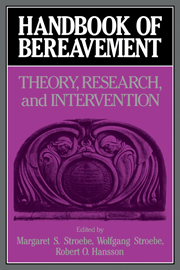Book contents
- Frontmatter
- Contents
- Contributors
- Preface
- Part I Introduction
- Part II The phenomenology and measurement of grief
- Part III Current theories of grief, mourning, and bereavement
- Part IV Physiological changes following bereavement
- Part V The psychological, social, and health impacts of conjugal bereavement
- Part VI Grief reactions to different types of loss
- 18 Loss and recovery
- 19 The death of a child is forever: The life course impact of child loss
- 20 Children's reactions to the death of a parent
- 21 Bereavement following death from AIDS: Unique problems, reactions, and special needs
- 22 Sleep and dreams in well-adjusted and less adjusted Holocaust survivors
- Part VII Coping, counseling, and therapy
- Part VIII Conclusions
- References
- Author index
- Subject Index
22 - Sleep and dreams in well-adjusted and less adjusted Holocaust survivors
Published online by Cambridge University Press: 04 May 2010
- Frontmatter
- Contents
- Contributors
- Preface
- Part I Introduction
- Part II The phenomenology and measurement of grief
- Part III Current theories of grief, mourning, and bereavement
- Part IV Physiological changes following bereavement
- Part V The psychological, social, and health impacts of conjugal bereavement
- Part VI Grief reactions to different types of loss
- 18 Loss and recovery
- 19 The death of a child is forever: The life course impact of child loss
- 20 Children's reactions to the death of a parent
- 21 Bereavement following death from AIDS: Unique problems, reactions, and special needs
- 22 Sleep and dreams in well-adjusted and less adjusted Holocaust survivors
- Part VII Coping, counseling, and therapy
- Part VIII Conclusions
- References
- Author index
- Subject Index
Summary
The Holocaust constituted an extreme trauma that produced long-term effects on the lives of the survivors. The systematic extermination of Jews in the concentration camps created situations previously unknown in history. The horrors and inhumanity that the inmates experienced daily in those camps are difficult to describe. The endless threat to life was faced each and every day, constituting a never-ending struggle to survive.
In addition, there were physical pressures, such as intense hunger, crowded quarters without even minimal hygienic conditions, gruelling work, exposure to bodily torture, and resulting diseases. Mental pressures included painful separation from one's family, often accompanied by the knowledge that dear ones had perished or were in a similar situation, and uncertainty about one's existence, how long the imprisonment would last, and what the future would hold. The camp prisoners endured methodical humiliation at the hands of the wardens. The inmates lost their identities: Their names were replaced by a serial number; their professions and social standing were also lost. All the values and the moral and social norms by which they had led their lives were destroyed.
Even after the Holocaust, the feeling of loss did not subside. Most survivors wandered from their homeland to other countries. As immigrants, they were forced to adjust to a new place, a new language, and new leadership, while distancing themselves or cutting themselves off altogether from their origins.
- Type
- Chapter
- Information
- Handbook of BereavementTheory, Research, and Intervention, pp. 331 - 346Publisher: Cambridge University PressPrint publication year: 1993
- 7
- Cited by



